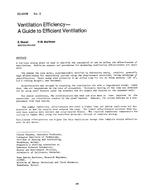Description
A two-zone mixing model is used to describe the concept(s) of and to define the effectiveness of ventilation. Multiroom aspects and procedures for measuring ventilation effectiveness are dealt with.
The simple two zone model, experimentally verified by laboratory tests, predicts generally high effectiveness for ventilating systems using the displacement principle, taking advantage of stratification. Tests using this principle in an office room for one to three persons (28 m², 2.8 m ceiling height), are reviewed.
Stratification was secured by supplying the ventilation air with a temperature always lower than the air temperature in the zone of occupation . Necessary heating of the room was provided for by using panel heaters under the windows; the air supply was located at the opposite wall.
For winter conditions, the stratification was weak and also more or less impaired by the convective air circulation created by the panel heaters. However, the system behaved as a disÂÂplacement flow type system.
For summer conditions, effectiveness was usually higher than for winter conditions but was dependent on how the surplus heat entered the room. The lowest effectiveness occurred when the only heat sources were persons and solar-heated floors. The required supply-air temperature for cooling is higher when using the described principle instead of complete mixing.
Ventilation effectiveness was higher for this ventilation design than complete mixing effectiveness in all tests.
Citation: Symposium, ASHRAE Transactions, 1983, vol. 89, pt. 2B, Washington, D.C.
Product Details
- Published:
- 1983
- Number of Pages:
- 16
- File Size:
- 1 file , 1.1 MB
- Product Code(s):
- D-DC-83-09-2




